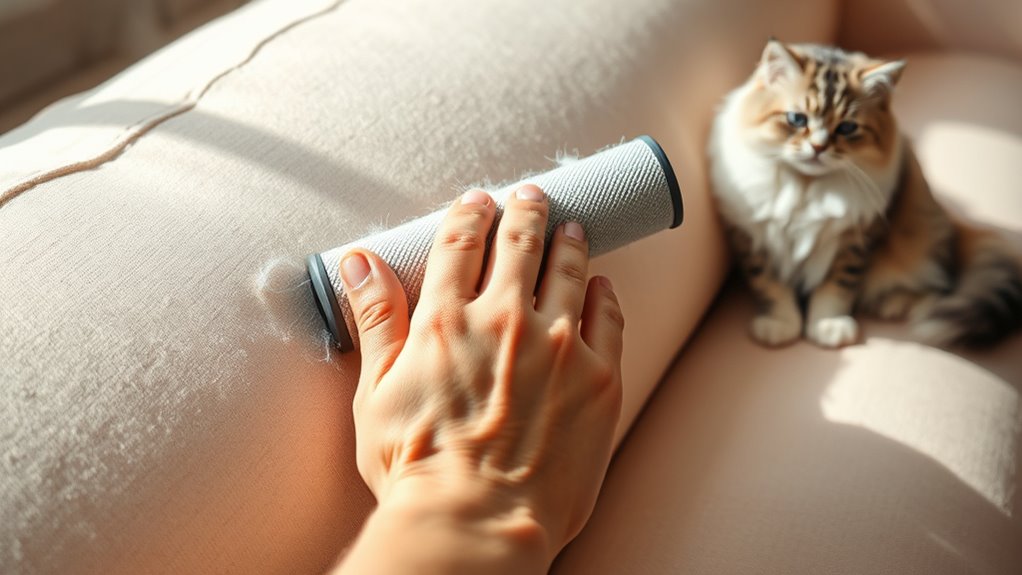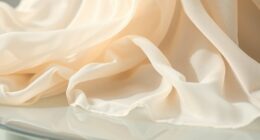To effectively remove pet hair and lint from fabrics, use a vacuum with the right upholstery attachment and make slow, deliberate passes to loosen and lift stubborn debris. Incorporate fabric softeners during washing or lightly mist fabrics beforehand to loosen hair. Keep tools like lint rollers or damp sponges handy for quick fixes. Regular maintenance of your vacuum and combining these techniques will lead to better results—discover more tips to keep your fabrics spotless.
Key Takeaways
- Use vacuum with upholstery or brush attachments, making slow, deliberate passes to loosen and lift pet hair effectively.
- Regularly vacuum fabrics and clean filters to maintain suction power and prevent pet hair from settling deeper.
- Add liquid fabric softener during laundry or lightly mist fabrics to loosen pet hair and lint for easier removal.
- Employ tools like lint rollers, rubber gloves, or damp sponges to quickly pick up pet hair from larger surfaces.
- Combine vacuuming, softener application, and manual tools for a thorough, consistent cleaning routine to keep fabrics pet-hair-free.

Pet hair and lint can quickly accumulate on your fabrics, making your home look untidy and your clothes less appealing. Tackling this problem effectively starts with understanding the right vacuum techniques. When you use your vacuum cleaner, switch to a brush or upholstery attachment designed for fabrics. This helps loosen and lift pet hair and lint from your furniture, curtains, and clothing. Make slow, deliberate passes over the surfaces, applying gentle pressure to guarantee you don’t push the hair deeper into the fibers. For best results, go over the same spot multiple times, especially in areas where pet hair tends to cling most. Also, adjusting the vacuum’s height setting can improve suction, making it easier to pick up stubborn hair. Remember, a consistent vacuum routine prevents hair from settling deeply into fabrics, reducing the need for more intensive cleaning later. Regularly cleaning your vacuum’s filters and brushes ensures consistent suction power, which is essential for removing embedded pet hair.
In addition to vacuuming, fabric softeners can be surprisingly effective for removing pet hair and lint. When washing clothes or bedding, add a small amount of liquid fabric softener to the rinse cycle. This helps loosen hair and lint from the fabric’s surface, making it easier to remove during drying. If you’re dealing with furniture or upholstery, lightly misting the fabric with a fabric softener solution can help loosen pet hair before vacuuming. Just be sure to test a small, hidden area first to guarantee the softener doesn’t stain or damage the material. On clothing, using fabric softener sheets in the dryer not only reduces static but also helps dislodge pet hair. Rubbing the softener sheet over clothing or furniture can also pick up loose hair and lint, especially when used in combination with vacuuming. Incorporating effective cleaning techniques can further enhance your efforts and keep fabrics fur-free.
Another practical tip is to keep a lint roller or adhesive lint tape nearby. These tools are quick and easy for removing pet hair from clothes or upholstery on the spot. For larger surfaces, use a rubber glove or a slightly damp sponge; the rubber creates static that attracts pet hair, making it easier to pick up. Regularly cleaning your vacuum’s filters and brushes ensures consistent suction power, which is essential for removing embedded pet hair. Combining these methods—effective vacuum techniques, the right use of fabric softeners, and handy tools—gives you a thorough approach to keep your fabrics free of pet hair and lint. With consistent effort, your home will look cleaner, your clothes will be more appealing, and you’ll enjoy a fresher, pet-hair-free environment.
Frequently Asked Questions
Can Pet Hair Damage Delicate Fabrics?
Pet hair can damage delicate fabrics if it causes excessive pulling or abrasion during removal. Fabric sensitivity varies, so some materials are more prone to damage from pet hair adhesion or removal methods. If you pull or scrub too hard, you risk weakening fibers or causing tears. To protect delicate fabrics, use gentle techniques like a soft brush or tape, and always test a small area first to avoid damage.
How Often Should I Clean My Lint Roller?
Think of your lint roller as a loyal garden hose—it needs regular maintenance to work effectively. You should clean your lint roller after every few uses or whenever it’s clogged with pet hair. Incorporate cleaning into your routine cleaning schedules, and follow simple maintenance tips like peeling away used sheets or washing reusable rollers. Staying on top of this keeps your fabrics pristine and your pet hair battles victorious.
Are Natural Remedies More Effective Than Commercial Tools?
Natural remedies can work well for removing pet hair and lint, especially with DIY solutions like damp rubber gloves or a mixture of baking soda and water. However, commercial products are often more effective and convenient, designed specifically for quick results. You might find that blending both options suits your needs best—try DIY methods for light cleaning and rely on commercial tools for stubborn pet hair.
Will Using a Hairdryer Remove Pet Hair?
Using a hairdryer can help loosen pet hair, but it’s not a magic bullet. The effectiveness of a hairdryer for pet hair removal depends on the setting and fabric type. High heat might blow hair away temporarily, but it won’t fully clear it from your clothes or furniture. To truly get rid of pet hair, combine the hairdryer with other methods like a lint roller or damp cloth.
Can Pet Hair Cause Allergies on Clothing?
Yes, pet hair can cause allergies on clothing. Pet dander, tiny skin flakes from your pets, often clings to fabrics and acts as allergy triggers. When you wear or handle clothes with pet hair, you might experience sneezing, itchy eyes, or congestion. To reduce this, regularly wash your clothes, use lint rollers, and keep pets off certain fabrics. Staying proactive helps minimize allergy symptoms caused by pet dander.
Conclusion
Think of your fabrics as delicate gardens, each pet hair and lint as stubborn weeds. With these methods, you’re like a gentle gardener, gently clearing away the unwanted debris to reveal the beauty beneath. Each swipe, brush, or tape becomes a nurturing hand, restoring your fabrics’ freshness. Soon, your home will bloom with clean, pristine surfaces—an inviting oasis where pet hair no longer shadows your space, and your fabrics shine like vibrant, well-tended flowers.









